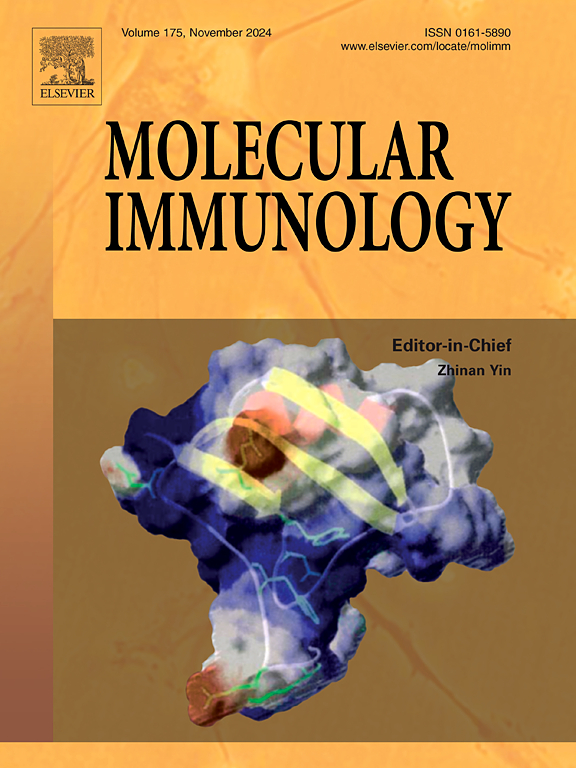Linker histone H1.3 promotes IFN-β production targeting MDA5 signaling to inhibit EMCV infection
IF 3
3区 医学
Q2 BIOCHEMISTRY & MOLECULAR BIOLOGY
引用次数: 0
Abstract
Multiple core histones play pivotal roles in viral infection process, as evidenced in influenza virus and other viruses. Recent findings indicate that linker histone H1.2 regulates the interferon signaling pathway to modulate influenza and EMCV infections, while H1.3 may also play a role in EMCV infection. In this study, we initially demonstrated that overexpression of H1.3 markedly suppressed the EMCV replication and proliferation. Conversely, knockdown of H1.3 expression led to an upregulation of EMCV replication and proliferation. Additionally, we observed a significant enhancement of EMCV-induced type I IFN production in Myc-H1.3 expressing cells. Our further exploration revealed that H1.3 upregulated the expression of MDA5 and enhanced the phosphorylation of TBK1 and IRF3 during EMCV infection, with opposite effects observed in H1.3 knockdown cells. Subsequently, we confirmed the interaction between H1.3 and MAVS, as well as IRF3, using both endogenous and exogenous Co-IP assays. Furthermore, we demonstrated that H1.3 promoted IRF3 phosphorylation and its nuclear translocation in EMCV-infected A549 cells. Notably, the N-terminal domain of H1.3 may play a crucial role in regulating the IFN-β signaling pathway to inhibit EMCV replication. Finally, we observed that EMCV infection upregulated the phosphorylation of H1.3, which may correlate with increased transcriptional expression of genes such as IFN-β. In summary, our findings address the gap in understanding the involvement of H1.3 in viral infection and elucidate the mechanism by which H1.3 negatively regulates EMCV replication. These findings may provide new insights into potential antiviral targets.
连接蛋白H1.3促进IFN-β的产生,靶向MDA5信号传导抑制EMCV感染
多个核心组蛋白在病毒感染过程中起着关键作用,这在流感病毒和其他病毒中得到了证明。最近的研究结果表明,连接蛋白H1.2调节干扰素信号通路以调节流感和EMCV感染,而H1.3也可能在EMCV感染中发挥作用。在本研究中,我们初步证明过表达H1.3可显著抑制EMCV的复制和增殖。相反,H1.3表达的下调导致EMCV复制和增殖的上调。此外,我们在表达Myc-H1.3的细胞中观察到emcv诱导的I型IFN产生的显著增强。我们进一步的研究发现,在EMCV感染期间,H1.3上调MDA5的表达,增强TBK1和IRF3的磷酸化,而在H1.3敲低的细胞中观察到相反的作用。随后,我们通过内源性和外源性Co-IP实验证实了H1.3与MAVS以及IRF3之间的相互作用。此外,我们证实H1.3在emcv感染的A549细胞中促进IRF3磷酸化及其核易位。值得注意的是,H1.3的n端结构域可能在调节IFN-β信号通路以抑制EMCV复制中发挥关键作用。最后,我们观察到EMCV感染上调了H1.3的磷酸化,这可能与IFN-β等基因的转录表达增加有关。总之,我们的研究结果填补了对H1.3参与病毒感染的理解空白,并阐明了H1.3负性调节EMCV复制的机制。这些发现可能为潜在的抗病毒靶点提供新的见解。
本文章由计算机程序翻译,如有差异,请以英文原文为准。
求助全文
约1分钟内获得全文
求助全文
来源期刊

Molecular immunology
医学-免疫学
CiteScore
6.90
自引率
2.80%
发文量
324
审稿时长
50 days
期刊介绍:
Molecular Immunology publishes original articles, reviews and commentaries on all areas of immunology, with a particular focus on description of cellular, biochemical or genetic mechanisms underlying immunological phenomena. Studies on all model organisms, from invertebrates to humans, are suitable. Examples include, but are not restricted to:
Infection, autoimmunity, transplantation, immunodeficiencies, inflammation and tumor immunology
Mechanisms of induction, regulation and termination of innate and adaptive immunity
Intercellular communication, cooperation and regulation
Intracellular mechanisms of immunity (endocytosis, protein trafficking, pathogen recognition, antigen presentation, etc)
Mechanisms of action of the cells and molecules of the immune system
Structural analysis
Development of the immune system
Comparative immunology and evolution of the immune system
"Omics" studies and bioinformatics
Vaccines, biotechnology and therapeutic manipulation of the immune system (therapeutic antibodies, cytokines, cellular therapies, etc)
Technical developments.
 求助内容:
求助内容: 应助结果提醒方式:
应助结果提醒方式:


